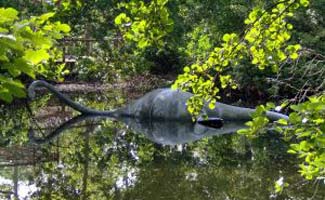The Brontosaurus Goes “Extinct”
 Over the past years the Brontosaurus has become no more. It is not the fact that the dinosaur disappeared, more that it never actually existed. The Brontosaurus as it was known to paleontologists was actually first discovered and classified as the Apatosaurus and due to rules of the International Code of Zoological Nomenclature the name which was documented first defaults. As a result approximately thirty years ago the Brontosaurus name began to fade out and the once grand and well recognized dinosaur received a name change. Despite the name change, however, this humongous beast of a dinosaur still holds a place in dinosaur lover’s hearts as a “favorite.”
Over the past years the Brontosaurus has become no more. It is not the fact that the dinosaur disappeared, more that it never actually existed. The Brontosaurus as it was known to paleontologists was actually first discovered and classified as the Apatosaurus and due to rules of the International Code of Zoological Nomenclature the name which was documented first defaults. As a result approximately thirty years ago the Brontosaurus name began to fade out and the once grand and well recognized dinosaur received a name change. Despite the name change, however, this humongous beast of a dinosaur still holds a place in dinosaur lover’s hearts as a “favorite.”
Brontosaurus: One of the Largest Creatures to Ever Walk on Our Planet
The Apatosaurus (Brontosaurus) first appeared on the dinosaur scene during the late Jurassic period in the age of the giant Sauropods. One hundred and fifty million years ago when the Apatosaurus (Brontosaurus) roamed the Earth it measured in at 23 metric tons and stood 75 feet tall, as such it remains one of the largest creatures to ever walk the planet Earth. The Apatosaurus (Brontosaurus) stood at 15 feet tall at its hips and is known particularly for its long neck and its whip like tail which measures in at approximately 50 feet long.
How Did Brontosaurus Eat?
Due to the length of its neck this giant herbivore is thought to have held its neck parallel to the ground rather than up above its body. Paleontologists hold a couple of theories as to how the Apatosaurus (Brontosaurus) used its long neck to feed. As opposed to popular misconception the mammoth herbivore did not reach its neck up to tall trees and rather it is thought to have either used its long neck in mowing motions to feed on vegetation or they used their long necks to reach out in to marshy ground to feed on lush swampy vegetation. Both of these theories hold ground due to the fact that the Apatosaurus (Brontosaurus) was so large it could not efficiently move through forests to feed on masses of vegetation, nor could it stand in swampy ground without sinking and thereby meeting a slow death.
Brontosaurus: Vegetarian Dinosaur (Herbivore)
Due to the sheer size of the Apatosaurus (Brontosaurus) they are believed to have spent most of their lives grazing and traveling. With the vast amount of vegetation that is required to keep a 23 metric ton dinosaur (think of approximately four elephants) full cannot be harvested from one area. From analysis of the Apatosaurus (Brontosaurus)’s teeth it is believed that the large herbivore raked vegetation with its teeth to strip the leaves from the branches. Rather than chewing up gathered material that it collected the Apatosaurus (Brontosaurus) had stomach stones which helped to break up and digest the large foliage and tough plants that would be swallowed whole.
What did Brontosaurus Eat?
The dominant flora during the late Jurassic period was made up by many conifers and most likely made up a large portion of the Apatosaurus (Brontosaurus)’s diet. Also thriving during the Apatosaurus (Brontosaurus)’s time were Caytoniaceous seed ferns, Bennettitales, and Cheirolepidiaceae which grew on lower vegetation lines. Throughout forests ginkgos and Dicksoniaceous tree ferns thrived and may well have been picked by the Dicksoniaceous tree ferns as they passed edges of the densely wooded areas.
Brontosaurus: Distinguishing Characteristics
Unlike the similarly constructed Diplodocus the Apatosaurus (Brontosaurus) had less elongated cervical vertebrae and was heavier than that of the Diplodocus. Another distinguishing difference between these two large Sauropods was that the Apatosaurus (Brontosaurus) has both longer and more robust legs than the Diplodocus as observed from the leg bones of both animals. It is also believed that the Apatosaurus (Brontosaurus) used its tail as a fifth leg to support itself when grazing taller vegetation, however, this theory is debated.
It is popularly believed that the Apatosaurus (Brontosaurus) spent its early years partially submerged in water to support its weight as was also believed of other massive Sauropods; however, recent research suggests that this would not have been possible as it would lead to suffocation of the animal. Also like the Diplodocus, paleontologists have come to believe that the Apatosaurus (Brontosaurus) held its neck to a 45 degree angle with its head pointing downward. Unlike other giant Sauropods a set of juvenile Apatosaurus (Brontosaurus) footprints discovered in 2006 by Matthew Mossbrucker in Morrison, Colorado suggest that juvenile Apatosaurus (Brontosaurus) were capable of running on their hind legs.
How Long Did Brontosaurus Live? 100 Years?
It is speculated by some dinosaur lovers that the Apatosaurus (Brontosaurus) as well as other Sauropods could have lived as long as one hundred years. While this large number gives the Apatosaurus (Brontosaurus) the air of importance over other dinosaurs it is not a number that can be proved or disproved at this time due to a lack of fossil evidence. There are currently only six partial specimens of Apatosaurus (Brontosaurus) in the hands of paleontologists and none of these confirm such a long life span.
Such a long lifespan may seem astronomical in terms of such a large animal; however, life spans of large creatures are not necessarily short. It is often assumed that large animals die sooner due to the strain on their heart as a result of pumping blood through such a large body but this is simply not true. A dinosaur like the Apatosaurus (Brontosaurus) was incredibly large but it also had an incredibly large heart which pumped its blood around its body. Aside from this fact it is not particularly bizarre for large creatures to have long life spans, take for example the elephant or, to a larger extreme the Bowhead Whale. As a considerably large land mammal the elephant can live well in to its eighties.
As a particularly large sea faring mammal the Bowhead Whale has been known to live as long as two hundred years – although this is slightly less applicable to the Apatosaurus (Brontosaurus) due to the fact that sea faring mammals often live longer lives than land faring mammals.
How did Brontosaurus Move and Live?
When considering the physiological structure of such a large creature paleontologists must recreate these giant beasts to attempt to learn more about their movements and basic living functions. One of the most puzzling factors that paleontologists have yet to completely figure out in regards to the Apatosaurus (Brontosaurus) is the mechanics of breathing. Such a large creature could never have survived submerged in water and based on the sheer amount of air that this size of an animal could take in the recreation of the respiratory system becomes a particularly puzzling task. While recreations of the Apatosaurus (Brontosaurus) respiratory system have been less fruitful than physiologists have hoped, computer animations replicating the size and weight of the Apatosaurus (Brontosaurus)’s tail have been more bountiful. An article in Discover Magazine in November 1997 reviewed computer animations by Nathan Myhrvold and found that the Apatosaurus (Brontosaurus) was more than likely capable of using its tail like a bullwhip and creating a sound which measures in at over 200 decibels.
Due to the nature of being so very large, the Apatosaurus (Brontosaurus) had to make some adaptations that smaller dinosaurs of the time did not face. One such adaptation includes the high blood pressure which was required to pump blood to all of the extremities of the Apatosaurus (Brontosaurus) including the extremely long neck. It is believed that the blood pressure of the Apatosaurus (Brontosaurus) was three to four times that of ours and the heart was massive in order to keep up with the demands of a 23 metric ton body.
Giant Heart, Tiny Brain
Unfortunately for the Apatosaurus (Brontosaurus) one of the things that did not adapt to accommodate its large size was its brain, this huge Sauropod had one of the smallest brains among all dinosaurs. On a more positive note the massive size of the Apatosaurus (Brontosaurus) alone was one of the reasons that this herbivore escaped many predators. With a head that stood above the largest of carnivores during the late Jurassic period the Apatosaurus (Brontosaurus) was able to protect its head and neck from attacks from predators. The huge bullwhip like tail as discussed previously also served as an efficient weapon to defend itself from attacks from predators. This not to say that Apatosaurus (Brontosaurus) was not susceptible to attacks as can be seen from a Apatosaurus (Brontosaurus) vertebrae which showed evidence of attack from an Allosaurus.
Where did Brontosaurus Live?
The Apatosaurus (Brontosaurus) is believed to have lived within Western North America, its fossils having been found in Colorado, Wyoming, Utah and Oklahoma. The Apatosaurus was first named in 1877 by a Yale University paleontology professor, Othniel Charles Marsh. The specimen he named as Apatosaurus was a juvenile and in 1879 when Marsh discovered a larger specimen he incorrectly labeled the second species as a Brontosaurus. As the biggest land animal ever seen, the fully grown Brontosaurus specimen was mounted in the Peabody Museum of Natural History in 1905 using bones from similar dinosaurs to fill in the missing pieces. As it turns out the head of the “Brontosaurus” display was actually the mock up of a head of a Camarasaurus. Since this display was labeled as the Brontosaurus the name stuck in the minds of public making it even more difficult to erase once it was discovered that the two specimens were the same dinosaur at two different points in time! Due to the fact that Marsh named the first of the two specimens Apatosaurus it was declared that the name should stand and the older term “Brontosaurus” should be used only as a synonym.
Brontosaurus Fossils: What We’ve Learned
Paleontologists have determined almost all of what they know about the Apatosaurus (Brontosaurus) from examining six partial skeletons that have been discovered throughout the Western United States. Of all of the Apatosaurus (Brontosaurus) fossils discovered the most complete fossil was found in the Morrison Formation in Colorado by Earl Douglass. Throughout discovery of fossils of the Apatosaurus (Brontosaurus) four species of the giant herbivore have been found, the Apatosaurus ajax which was found in Colorado, the A. excelsus which was found in Oklahoma, Utah and Wyoming, the A. louisae which was found in Colorado and the A. yahnahpin which was found in Wyoming.
Despite there only being six partial skeletal remains of the Apatosaurus (Brontosaurus) in existence much can be determined about this mammoth dinosaur from other giant Sauropods which lived in the same era and showed similar physiological characteristics. Some seemingly simple facts about the Apatosaurus (Brontosaurus) have been determined from tiny physiological features. One example of such a fact includes the fact that the vertebrae of the Apatosaurus (Brontosaurus) neck would not have allowed the dinosaur to lift its head up above the top of its back. Due to the setting of the neck vertebrae the neck could not have been lifted up above the level of the back without the vertebrae pushing against each other and the back being arched – a position which would have been exceedingly uncomfortable for this giant herbivore! Other factors such as the build and length of the Apatosaurus (Brontosaurus) tail tell paleontologists much about the humongous dinosaurs’ ability to move as well as defend itself. Additionally damage to the six partial skeletons assist paleontologists in determining what type of predators attempted to feast on the Apatosaurus (Brontosaurus).
While there is little evidence of the life of the Apatosaurus (Brontosaurus) in comparison to other dinosaurs whose fossils are much more numerous, the large beast holds a specific fascination for paleontologists and animal lovers alike. What is it about this huge beast that draws us all to it? Aside from being seen as a gentle herbivore, the Apatosaurus (Brontosaurus) was such a truly giant creature that it seems too fantastical to be true. Without the proof of skeletal remains it would never be believed that such a giant creature could exist, let alone live the lifespan that some paleontologists assume – one hundred years!





Can anyone tell me why the apatosaurus became extinct?
I would like to know the classification on the Brontosaurus and I could not find it on here, so that would be helpful information for me right now.
Where have the Brontosaurus remains been found?
Thank you for your question. Apatosaurus or Brontosaurus remains have been found in Mexico and in North America since these giant beasts roamed throughout that territory when alive. One of the more complete specimens of Brontosaurus was found in Como Bluff, Wyoming in 1879 by Othniel Charles Marsh. Footprints from the juvenile Apatosaurus have also been found in Quarry Five in Morrison, Colorado. The Morrison formations are well known for many Apatosaurus remains and when it comes to the dinosaur species that frequented this area, Apatosaurus was the second most common sauropod!
The Brontosaurus has got to be my favorite dino. Being a vegetarian, I can relate to it better than say, the T-Rex. One thing that I don’t understand is the name change to Apatosaurus. I can barely spell that! We grew up as kids knowing this gentle herbivore by the name Brontosaurus, and I think it should stay that way. I don’t suppose you could add a poll to the site? Thanks and wonderful site! I can’t wait to learn and see more about my favorite time period on Earth (besides the one I’m in of course).
I had to say that this dinosaur is the most popular dinosaur in the universe. Brontosaurus Apatosaurus you name but this is still the most popular dinosaur in the world!